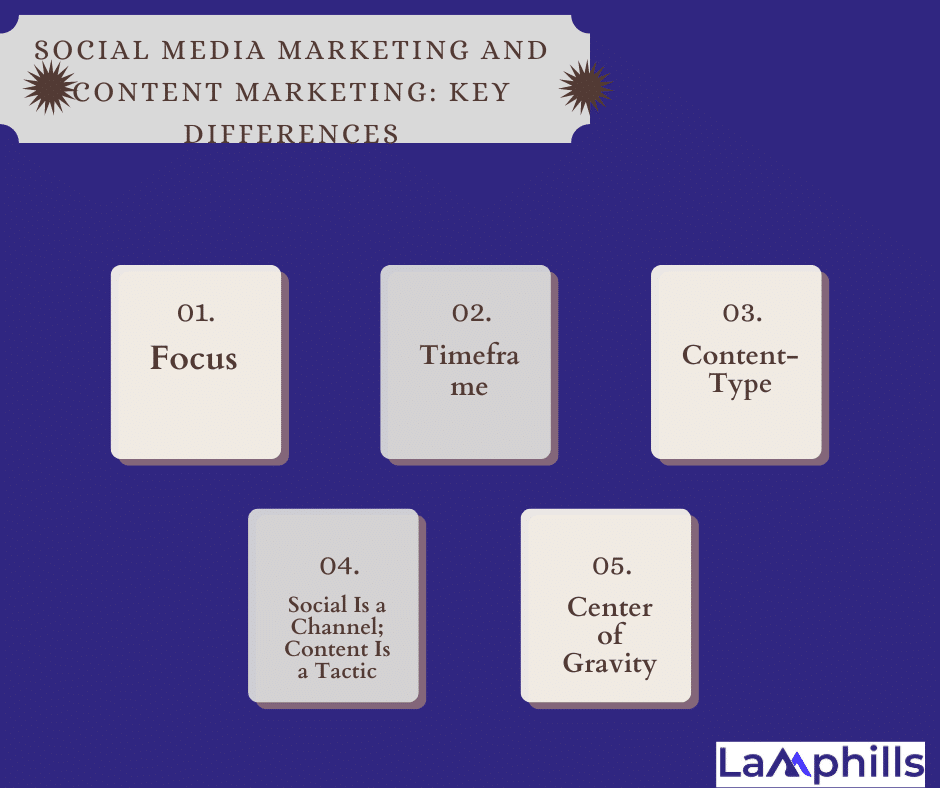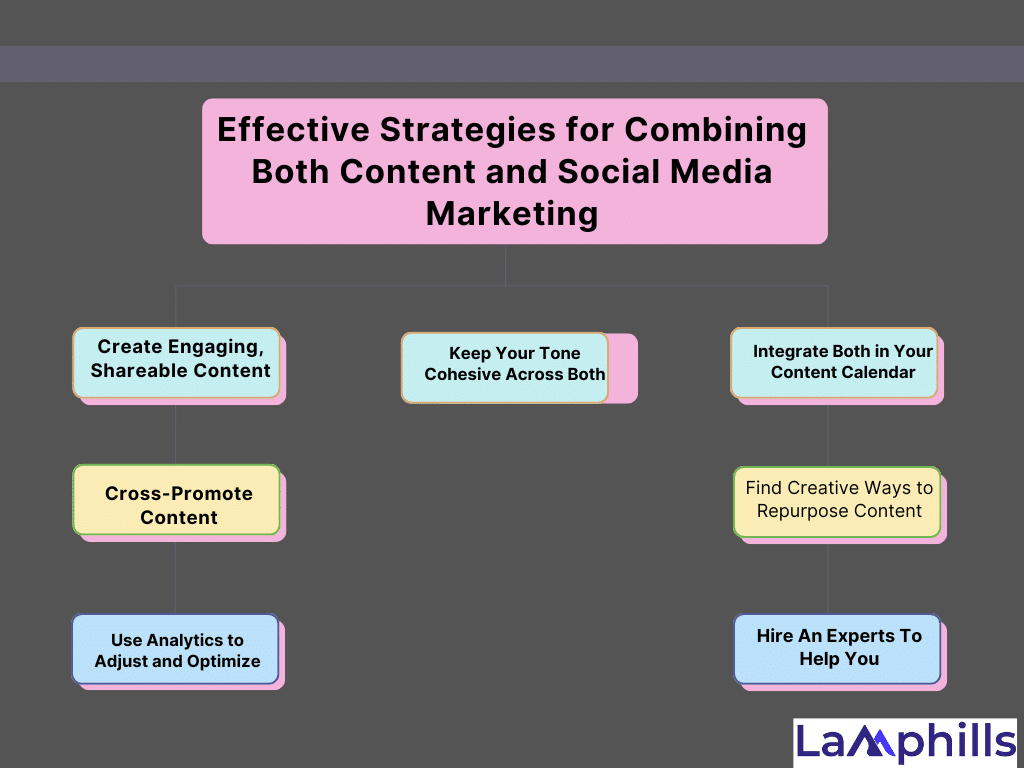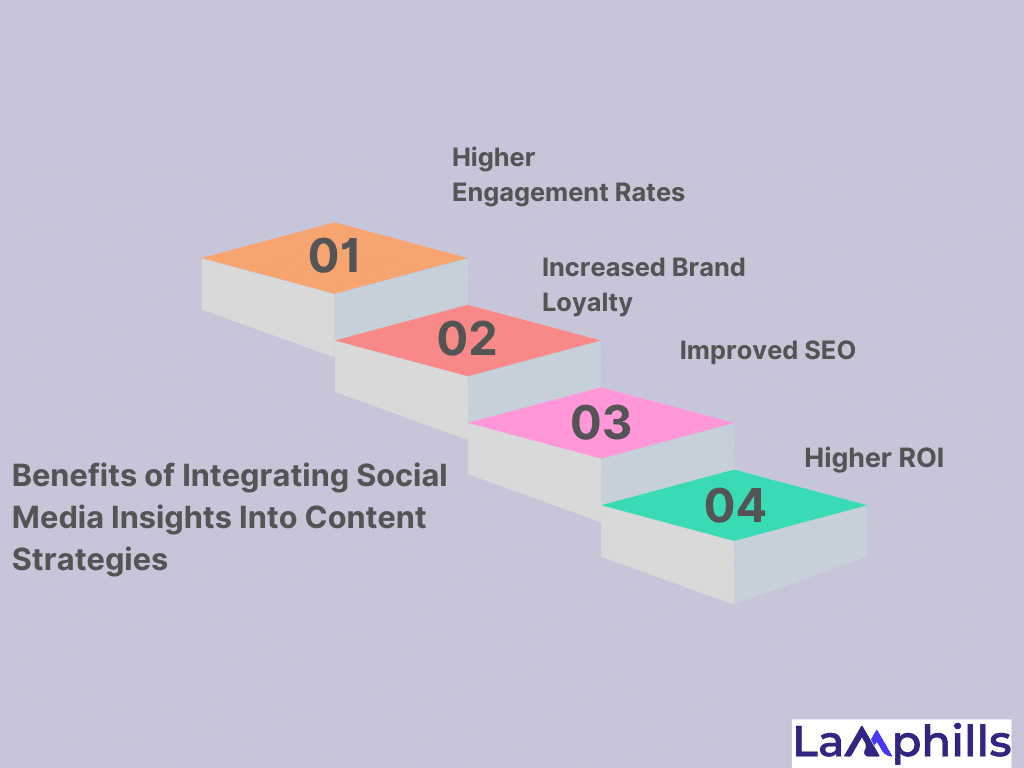When I initially started with social media and content marketing, they seemed like two very different worlds. I’d spend hours writing blog pieces, publishing them on Facebook, and waiting for them to acquire traction. But here’s the truth: simply putting stuff on social media and hoping for engagement does not work. It’s like having a party but forgetting to send out invites! The key to success is to integrate social media and content marketing into a single, seamless campaign. This combination is the secret behind many of today’s most successful companies. In this comprehensive guide to social media and content marketing, I’ll touch on everything you need to know to knock out your marketing goals. park. I’ll cover the differences between the two and let you in on some best practices for knowing when and how to apply each.
Key Takeaways
- The magic of successful marketing lies in integrating social media with content marketing. Separating the two is ineffective, but when combined, they create a powerful strategy that drives engagement and amplifies a brand’s reach.
- Content marketing doesn’t just attract leads; it builds authority and trust with potential customers by offering valuable information. A strong content strategy can establish expertise and foster long-term relationships.
- Social media platforms allow businesses to engage directly with their audience through comments, feedback, and conversations. This interaction fosters real-time relationships that can drive brand loyalty and customer satisfaction.
- A winning strategy involves promoting content across different channels. Cross-promotion, like sharing blog posts on social media or using social media insights to create targeted content, ensures wider reach and higher engagement.
- Measuring performance through analytics is crucial for refining content and social media strategies. By understanding what works and what doesn’t, businesses can continuously optimize their approach for better engagement and conversions.
What is Content Marketing?

Content marketing is the practice of acquiring new consumers by providing unique material that is relevant to target audiences. This content can educate or entertain audiences, but it should be valuable enough for them to share with their friends or link to in their content.
A solid content marketing plan not only strengthens your social campaign, but it also establishes familiarity, likeability, and trust between you and your customers. At its foundation, content marketing seeks new customers by promoting creative (and unique) material that is both valuable and interesting. Content is created to attract and keep target audiences by providing information that encourages them to convert or engage with your business.
Assume you recently noticed a leak in your bathroom sink. Your first thought may be to look online for answers. More than likely, one of the top results will be a blog article that offers exactly that, most likely from a local small business.
Reading the blog not only helps you solve the problem but also introduces you to the company’s brand. And, by addressing your questions and providing solutions, they may even inspire you to call them again. In a nutshell, that is a content marketing plan put into action. With interesting content, you can establish expertise, gain trust, and turn a potential customer into a real buyer.
Why Use Content Marketing?
Without a doubt, content creation is worth the marketing effort. Here’s a non-exhaustive list of benefits you can expect from an effective content strategy:
- Strong results: 83% of B2B content marketers say their marketing strategy increased brand awareness, and 63% say it improved demand and lead generation.
- Low barrier of entry: Small business or enterprise—it doesn’t matter. Content creation is primarily a digital marketing strategy, meaning any size organization can start with minimal investment.
- Shorter sales cycle: Distributing valuable content can help a potential customer reach their buying decision faster and with conviction.
- Builds authority: Producing quality content that addresses industry topics can position your brand as a trusted thought leader. Authority instills trust, which in turn drives sales and business growth.
Content Marketing Examples
Engaging content comes in many forms. Let’s take a look at some of the most common (and effective!):
- Blogs: A blog post is to a marketer what a chord is to a musician, providing the foundation for a harmonious content strategy. Plus, with search engine optimization (SEO), you can use blogs to drive website traffic and reach a wider audience.
- Email: Email marketing is often its marketing strategy, but also intertwines with content creation. For instance, newsletters can help distribute valuable content to your target audience for maximum impact.
- Video: Video marketing, such as a product explainer or “about us” video, offers a chance to communicate your brand’s message and capture attention visually.
What Is Social Media Marketing?

People spend time on social media, and content marketing captures their attention. This mean if you don’t combine the two, you’re missing out on one of the best ways to connect with your audience.
Take social media as a platform on which your content can perform. Without amazing content, there is nothing to show the viewers. Without social media, your content may not even make it out of the dressing room.
A typical social media strategy consists of communicating with followers, distributing content, and placing sponsored ads. In a more casual atmosphere, social media platforms provide a fun and engaging approach for your target audience to find and connect with your company.
According to a recent study by HubSpot, 73% of marketers believe social media is effective for their business, and companies that blog see 55% more website visitors than those that don’t. When you integrate the two, you’re exponentially increasing your chances of connecting with your audience.
Why Use Social Media Marketing?
When you consider the benefits of social media marketing, you wont be surprise why companies around the world are using it to their advantage:
- Direct connection: Each social channel gives you a direct line of communication to your target audience—and vice versa. If someone wants to start a conversation with your brand, they know exactly where to go.
- Global reach: Over 5 billion people use social media. That alone makes it a must-have part of your overall marketing effort.
- Brand awareness: An active social media presence will help keep your brand top of mind for consumers and increase name recognition.
- Customer feedback: Social listening allows you to keep an ear to the ground — or in this case, to the internet. Gathering feedback can help inform your next social media campaign and drive continuous improvement.
Social Media Marketing Examples
A social media strategy includes numerous platforms and engagement tactics. Depending on the target audience, you might use:
- Social media advertising: Paid advertising, like Facebook ads, can broadcast social media posts to a wider audience for a low, cost-effective price. It’s a pay-per-click model, so you only pay when someone engages with the ad.
- Imagery and video: Nothing stops the scroll like an eye-popping graphic or video. Adding images to your posts can help your message resonate with visual learners.
- Influencer marketing: Collaborating with influencers can help you tap into their large following to promote your brand, products, or services and reach new customers.
Of course, organic approaches also yield significant results. For instance, when Total Safety needed help sharing new company messaging, we devised a fully organic social media strategy to spread the word.
Ultimately, Total Safety achieved a 351% increase in Facebook impressions, a 644% leap in Facebook engagement, and a 154% boost on LinkedIn — all by simply expanding content relevance and posting more often.
Social Media Marketing and Content Marketing: Key Differences

Now that you know a bit about each marketing strategy, let’s discuss what sets them apart. Take a look at a quick overview of how social and content marketing differ:
#1. Focus
Content marketing spans a wide range of venues, among which social media is typically only one. Your brand’s website serves as its focal point, also known as its “center of gravity”. In other words, regardless of content type or channel, the goal is to send as many users as possible to a page where they can learn more about your products and services, request a demo, or make a purchase.
In contrast, a social media marketing approach focuses on interacting with potential clients rather than increasing website traffic. Essentially, social media material is a conversation. Each social site supports two-way contact, allowing followers to provide feedback, ask questions, and send direct messages.
#2. Timeframe
When it comes to witnessing outcomes, content and social have two distinct time scopes. Content strategy is rarely about instant victories. Rather, content marketers concentrate on long-term outcomes such as trust, brand visibility, and, perhaps, conversions. After all, search engine optimization can take up to a year to yield results — but once it does, you’re off to the races.
A social media marketing plan is different. It emphasizes the short term, seeking immediate engagement and direct audience engagements. By definition, social media sites encourage speedier activities, such as likes, shares, and comments.
#3. Content-Type
Content marketing strategies mostly involve shares and content — generally, anything longer than 1,500 words. That can include blogs, eBooks, white papers, case studies, podcasts, and more. These assets are meant to address pain points and provide solutions, but to do that, they need ample room to work with. Hence, they tend to be on the longer side. Social media marketing is short-form, primarily for two reasons:
- Social media is a mobile channel where users have shorter attention spans and more distractions.
- Most platforms have tight restrictions, such as character limits and word counts.
So, social media content is often snappier, shorter, and sweeter. It can include 30-second video clips, interactive polls, memes, and other highly engaging, attention-grabbing formats.
#4. Social Is a Channel; Content Is a Tactic
Social media has revolutionized marketing. The rise of social media has made custom targeting of potential audiences simple for marketers. It is the most significant technological revolution, improving not only communication but also enterprises’ ability to market directly. Social media marketing is a medium for businesses to locate potential clients. It has evolved as a prominent marketing medium for businesses. It is an excellent method for listening and obtaining insights for your organization, as well as identifying and engaging with prospects and consumers. Social media marketing strategies perform best when combined with other marketing tactics.
On the other hand, content marketing is a tactic. It is a way of marketing that enables organizations to add value for potential customers by creating and distributing valuable content. Content marketing includes collaterals such as blog posts, videos, and web pages. These pieces of collateral help organizations to educate and entertain their target audiences. Content marketing is a tactic of marketing, which is intended by marketers to generate interest in offerings by reinforcing any problems, challenges, or solutions.
#5. Center of Gravity
The center of gravity is another distinction between social media and content marketing. The center of gravity is defined as the focal point of marketing activities. The focus of social media marketing is on social media networks. Running a social media campaign is similar to functioning within social networks. Marketers run social media marketing on Facebook, Twitter, and Google+, among other platforms. Social media marketers create content within these networks.
In contrast, the center of gravity for content markers is a brand’s website. Social networks play an important role in improving the success of content marketing campaigns. Social networking sites like Facebook, Twitter, and Google+ are primarily used as distributors of the link of the website. In the case of content marketing, marketers do not make use of social media platforms as a container of the content itself. In simple terms, we can say that social media marketing makes use of social media platforms as primary sources of marketing. Content marketing uses social media platforms as a distributor of a link back to the content on the website of the brand.
Effective Strategies for Combining Both Content and Social Media Marketing

Investing in your content marketing and social media marketing campaigns separately is a solid start to making the most of both. Combining these two strategies can result in a more cohesive and powerful marketing approach. Here are some expert strategies to try.
#1. Create Engaging, Shareable Content
Now comes the fun part—creating the content! In my experience, the best-performing content is either educational, inspirational, or entertaining. When you align that content with the right social media channels, it’s a recipe for success.
Types of Content that Work Well
- Videos: Short-form videos (like Reels and TikToks) are a hit for social media.
- Infographics: These are great for sharing key stats or tips in a visually appealing format.
- User-Generated Content: Encouraging your followers to create content for you not only fosters engagement but also builds a community around your brand.
When I started posting educational videos on marketing tips on Instagram, I noticed a significant spike in engagement. The content resonated with my audience because it was both helpful and easy to consume. Plus, it was shareable—my followers would send the videos to friends or repost them on their stories.
#2. Keep Your Tone Cohesive Across Both
Brands, like people, have distinct personalities, voices, ideals, and approaches to connecting with others. These qualities must be the same across all platforms. This consistency guarantees that your audience has a consistent brand experience, no matter where they interact with your content.
For example, a client should be able to go to your Facebook page or X profile and consume information that “feels” like what they’re already reading on your blog or in your email newsletter. If that is not the case with your brand, now is the moment to tighten things up. Check out how Wendy’s, GoPro, and Nike approach this and be inspired.
#3. Integrate Both in Your Content Calendar
Consistency is essential. One of the most common mistakes I encounter is intermittent publishing. You must keep a consistent drumbeat of content. A content calendar can help you organize your postings and keep a consistent presence across channels.
In my early days of content marketing, I was all over the place, posting whenever I felt like it, which resulted in low interaction. Once I started using a content calendar, I was able to schedule my blog pieces, social media updates, and promotional content in a structured manner, which made a significant difference.
A successful continuous content strategy requires thorough planning as far in advance as possible. Content calendars eliminate the guesswork in organizing, planning, and generating.
content, especially as your business grows and you take on additional team members to help with various tasks.
Include both your marketing content and your social media posts. Identify opportunities to combine the two in creative ways that serve your audience. As always, ensure that everything you plan fully aligns with your brand voice and company values.
#4. Cross-Promote Content
Social media posts and traditional material work better together than you might expect, and there is several potential for cross-promotion. To capture attention and offer value, you can promote your most recent blog posts and product launches throughout your social media networks with interesting images such as screenshots, infographics, or bespoke imagery. To add visual interest to your blog entries and textual content, you can integrate tweets and YouTube videos, as well as screen grabs from major social media platforms.
#5. Find Creative Ways to Repurpose Content
Keeping multiple content channels and social media profiles perpetually filled with terrific content is no easy feat, so it pays to do what you can to make your best ideas go as far as possible. Content repurposing is one highly effective way to do that. Here are some examples of how creative content repurposing can work:
- Break down YouTube videos and how-to guides into graphic sequences you can post to Instagram.
- Sum up key points and important takeaways from popular informative blogs in an infographic you can share on Facebook, Pinterest, X, or Threads.
- Expand your best long-form blogs into ebooks and use social media to promote them.
- Repurpose long-form content into social media-friendly short-form videos.
- Translate a popular webinar or e-course into a series of Instagram reels or TikTok videos.
#6. Use Analytics to Adjust and Optimize
You can’t improve what you don’t measure. Use analytics to track how your social media and content marketing efforts are performing. Look at metrics like reach, engagement, click-through rates, and conversions.
I’ve had posts I thought would perform well and flop. Instead of being discouraged, I used the data to understand why. Was it the timing? The format? The messaging? Over time, I refined my strategy to produce content that consistently resonated with my audience.
#7. Hire An Experts To Help You
As your company grows and the demands on your content strategy increase, outsourcing to maintain quality and creativity may be advantageous. Some people buy pre-written articles to help fill critical content gaps.
You can also engage a reputable full-service content creation provider, such as Crowd Content, to assist you with the complete process. We’ll help you manage your workload and incorporate new ideas into your approach. We’ll also offer support with anything from dynamic web content to engaging social media postings and skilled content management.
Benefits of Integrating Social Media Insights Into Content Strategies

Insights gained from your experiences engaging with audiences on social media can be priceless assets when it comes to fortifying your content marketing strategies. You can get a read on what your audience truly likes and dislikes, as well as how they feel about various content approaches. You can then apply what you learn to reap benefits like the following:.
#1. Higher Engagement Rates
When you know exactly what your target audience is interested in, you can utilize that knowledge to create more of the type of content that your consumers enjoy and find beneficial. Applying these insights allows you to more precisely personalize your content, resulting in material that not only captures attention but also stimulates interaction.
#2. Increased Brand Loyalty
Consider someone you know who is always available to you—who always has the appropriate answer to your queries and the finest advice on a certain topic. You trust them, and you are devoted to them. Consumer interactions with brands develop in similar ways, and using social media analytics intelligently can help your organization achieve this.
#3. Improved SEO
Shares and other forms of social media engagement are strong signals to search engines that a brand is producing high-quality content. Using what you discover about your clients on social media to increase engagement boosts traffic to your website and improves your overall SEO efforts.
#4. Higher ROI
Both content and social media marketing are investments in your business. It is not only about money or budgets. Time, work, and mental energy are all resources, therefore, ensuring a high return on that investment is critical. Integrating social media analytics into your approach might help you hit the correct notes more frequently, increasing your ROI dramatically.
How do content marketing and social media work together?
create an effective strategy companies use to grow their brand and online reach and engage with their target audience.
What content works best on social media?
They are,
- User-generated content (UGC) UGC is content others create and you repost (while giving credit to the original creator).
- Quotes. Quotes are widely popular on social media.
- Podcasts.
- Live streams
What is a social media marketer and content creator?
Their job is to understand what resonates with the audience and effectively incorporate it into the content, ultimately driving sales.
How do you get into social media marketing with no experience?
Becoming a social media manager with no experience
- Consider a college degree.
- Build your online community.
- Take a social media marketing course.
- Research tools you can use for social media management.
- Network online and in person.
- Volunteer to manage social media for small businesses.
Conclusion
Now that you know the difference between social media and content marketing, it’s time to start creating content. However, many business owners may not be sure what to do next. They know they need content, but how do they obtain it?
Integrating social media and content marketing is essential for developing a winning approach. When done correctly, these two can form an effective combo that boosts engagement, trust, and brand visibility.
So start small. Plan your content, distribute it intelligently, and most importantly, engage with your audience. You will soon be on the path to long-term business success.
If you’re looking to boost your business strategy, now’s the time to start combining your content marketing with social media. Need help getting started? Reach out, and let’s work together to build a strategy that works for you!
References
Related Articles
- How I Create Effective Content Pillars for Marketing Strategy: A Guide for Marketers
- Social Media Monitoring Platforms: An Expert Guide to Improve Your Engagement
- How I Build a Social Media Marketing Dashboard for Brands in 2024
- How to Choose a Social Media Content Creator: 6 Best Tips for Your Brand






